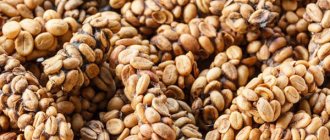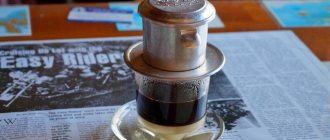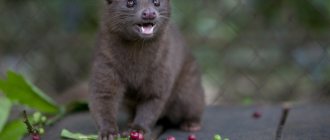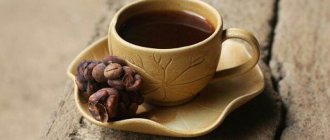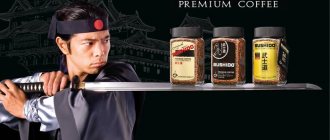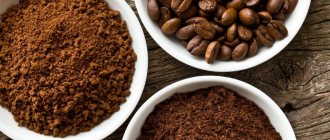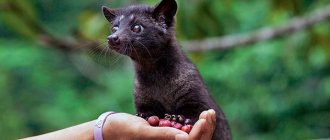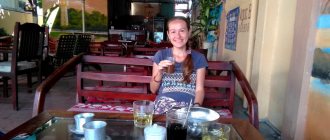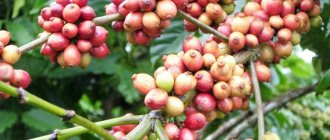Production Features
Coffee berries are usually collected by people manually or mechanically, after which the fruits are washed, dried under the sun, and cleared of pulp and shell. The whole process takes a lot of time, and musangs cope with processing on average in a day.
- Don't miss: Interesting and little-known facts about coffee
In the stomach of an animal that eats coffee beans, fermentation of the berries occurs. The workers just have to wash, dry and fry the resulting product. A civet can eat up to 500 g of fruit per day, and a much smaller amount retains its presentation.
In nature, animals select only the best berries, but in cages they are forced to eat what farmers give. Running after wild animals in search of excrement is a dubious pleasure, and the process itself is not very productive. For this reason, modern expensive Luwak coffee is produced by animals imprisoned in cages.
Musangs are not able to reproduce in captivity, which is why the composition of the farm is constantly updated. You can get no more than 270 kg of animal-fermented coffee per year. The low figures are explained by seasonality and the limited number of musangs involved in the production process.
The Luwak animal is an unusual producer of elite coffee.
The small Luwak animal, also known as the musang or palm civet, belongs to the civet family. Tropical forests are the main habitat of musangs, but their habitat is quite diverse. The main distribution area of luwak is Africa, South and Southeast Asia, including the Philippines and Indonesia. The Luwak animal, with a body weight of 1 to 15 kg, resembles a marten or ferret in appearance, its body length varies from 30 cm to 1 meter. Luwak are active mainly at night. The Luwak animal is often the target of hunters who want to get not only the valuable civet fur, but also edible meat.
Nutrition
The Luwak animal lives in trees and is a small predator, but the basis of its diet is not only meat, but also various insects, as well as fruits, nuts and other plant components, including coffee tree beans. Musangs carefully select the ripest and most intact coffee beans thanks to their sense of smell, which allows them to find aromatic and tasty coffee beans.
Production of elite coffee
The Luwak animal eats so much coffee beans that it cannot digest them. When coffee beans enter the Luwak body, they ferment, which subsequently affects the taste of the beans. In the stomach of the animal, the process of digestion of the pulp of coffee fruits occurs, and the coffee seeds are excreted naturally, acquiring a slightly changed appearance. They are collected, thoroughly cleaned and washed to remove Luwak droppings. After this, coffee plantation workers dry the coffee beans in the sun - so they are lightly roasted. After such actions, the sale of coffee begins, which often depicts a luwak - an animal that “produces” an elite product.
Research results show that such coffee is safe for consumers, since after careful processing of the beans, there are practically no pathogenic bacteria in them, and subsequent roasting of the beans kills the remaining ones.
The production of such coffee requires a lot of manual work, takes a lot of time and effort, so it is produced in small quantities. The rarity and high cost of coffee is a consequence of the destruction of the Luwak's natural habitat, which causes a decrease in their numbers.
Until some time, palm civets were considered dangerous pests that ate all the ripe fruits, so they were exterminated by Indonesian farmers. However, as it turned out, it was in vain, since with the help of these small animals one can earn a lot of money in the production of elite coffee called “Kopi Luwak”, which has become the most expensive to date.
A little history
When Indonesia was a Dutch colonial possession, local farmers were increasingly taxed in the form of coffee beans, which were highly valued by the local population. Then Indonesian farmers noticed that coffee beans from musang excrement were practically indigestible, so they began to carefully clean them and ship them to the Netherlands. However, coffee made from these beans turned out to be so aromatic and tasty that it began to gain popularity outside Indonesia. This is how the original technology for producing Kopi Luwak coffee was born, which today is considered the rarest and most unusual. Many coffee lovers describe it as an aromatic drink that has a caramel flavor with a hint of chocolate. Whether you try this coffee or not is up to you!
Taste characteristics of an expensive drink
Under the influence of the civet's gastric juice, the grains are deprived of some components. Acids and some of the protein compounds that give regular coffee its characteristic bitterness are neutralized. After high-quality washing and frying, there are no foreign odors or aftertaste.
True connoisseurs of the exotic drink note honey and caramel tones in the brewed portion, as well as light chocolate notes.
The taste is balanced by reducing acidity and bitterness due to the participation of another unique substance in the processing of berries - civet. Musk is produced by the glands of only these small animals, which is the originality of the production. Real coffee processed by animals can also have a pleasant creamy taste with subtle notes of vanilla.
How did the idea of producing the most expensive coffee from dung come about?
When the Dutch took over the coffee plantations, they prohibited local residents from collecting beans for personal consumption. For you:
How to properly brew coffee with cardamom and what is its specialty?
No one imposed such restrictions on musangs, so it was decided to extract coffee berries from their feces, wash, dry and prepare coffee.
Surprised to discover that the beans obtained in this way had a richer and more unusual taste, people quickly stopped treating Luwak coffee as a second-rate drink, and enterprising planters quickly put production on stream.
Classic cooking method
Residents of Sumatra brew the drink according to a traditional recipe:
- 1 ½ tsp. Place ultra-fine ground Luwak coffee into a well-heated ceramic container.
- Add 160 ml of boiled water, cooled to a temperature of 90 °C.
- Mix the ingredients thoroughly, cover with a saucer and let sit for no longer than 5 minutes.
This is interesting: How coffee is brewed in Vietnam
Luwak coffee producers believe that the taste of the drink is maximized when ground with powder.
How to brew Luwak correctly?
In many countries, coffee is brewed in Turks, and they also use modern coffee makers and coffee machines. These methods are not common in Vietnam.
Vietnamese teapots, condensed milk and ice.
Before trying Luwak, like any other variety, you must perform the following traditional ritual:
- You will need the so-called fin. This device is somewhat reminiscent of a mini drip teapot. It consists of a small metal cup with holes in the bottom, a round saucer also with holes, a kind of press and a lid.
- Place the flat saucer on the mug first, and then the glass itself.
- Pour a small amount of coffee into a glass. You need to leave room for water.
- Place a press on top, but you don’t need to press hard.
- Pour hot water, cover with a lid.
- Wait until the fragrant contents of the glass appear in the mug, drop by drop.
- Drink and enjoy!
Of course, you can brew coffee in a more conventional way, but to fully experience the magic of the Vietnamese drink, we recommend following local technology.
As we wrote above, in Vietnam coffee is traditionally served with ice, with condensed milk added if desired. Chilled green tea is also served along with it. These are the local traditions!
For a better taste experience, we recommend tasting without sugar. At least for starters. And most importantly, take your time, imagine that the moment has stopped! This is exactly what the Vietnamese do - they sit in a coffee shop for a long, long time, in absolutely no hurry.
Original and analogues of the product
It is almost impossible to find the real Kopi Luwak variety in the public market. By naturalness, experts mean the participation of free animals in the process. The human function is to travel through the jungle in search of animal excrement - the “wild” harvest is no more than 80 kg of grains per year.
Nowadays, some of the most expensive coffee in the world is made from dung on the farm, which reduces the value of the product. The closer the product is to the country of origin, the lower the risk of purchasing a counterfeit.
Modern entrepreneurs have taken the natural fermentation process as a basis and brought new varieties of the drink to the market. For example, Thais get their coffee from elephant dung, Black Ivory Coffee.
Kopi Chon is the name for coffee made from animal feces from Vietnam. The palm marten also lives there, but in the local dialect it sounds “chon”, not “luwak”. The production scheme is no different from Kopi Luwak, but the Thai variety received a good advertising campaign, and the Vietnamese brand is not yet very popular.
WHAT IS THIS BEAST, CIVETTA?
The genus of civets, or civets, is part of the civet family. These are carnivorous mammals that live in the tropical regions of Africa, southeast and southern Asia. In countries where English is spoken, these animals are called civets , in all others - civets or civets . There are 35 species included in 15 genera from the viverridae family. The most famous of them belong to the genera of civets: Owston's civet, otter civet, Kalimantan civet, striped civet, three-striped civet, Sulawesi civet, Himalayan civet, African civet, small civet, musang. Different species of civets have different body sizes. The smallest are the small civet, palm civet, three-lined civet - 45-55 cm body length, 1.7-2.5 kg in weight. Large civet species reach 80 cm in length and 7-9 kg body weight. The tails of different species of civets are of different lengths: some are almost the same as the body length, some are shorter. Almost all types of civets, in addition to small species of living creatures (birds, squirrels, rats, amphibians, worms, beetles, crustaceans, etc.), also feed on fruits, fruits, nuts, and roots. Civets are nocturnal animals. Only during the mating season are they active during daylight hours. Their main location is trees. Civets are the best of all predatory animals to move through trees, almost like squirrels. Many species of civets make nests in hollows. But some inhabit caves, burrows and human buildings (barns, stables). Some species of civets give birth once a year, and some - twice. They usually have 2-3 cubs per litter, some species have up to 5 cubs. The female feeds them with milk for a year. The lifespan of viverrids ranges from 5-7 years to 15 years in the wild. In captivity, some animals lived up to 25 years.
photo: Civets
Current prices
The most expensive coffee today is Black Ivory - the cost reaches $1,200 per 1 kg of beans. The price of Luwak coffee in Vietnam is 180 USD. per kilogram, “wild” is an order of magnitude more expensive - the maximum level is set at 4000 USD. It is recommended to buy the product directly from farmers if you are planning a holiday in countries with established production.
You can contact official dealers, but there is a risk of purchasing a low-quality product. The price of Luwak coffee in Moscow for 1 kg varies between 25-30 thousand rubles, so the number of people wishing to distribute counterfeits is increasing every year.
The rise in popularity of one of the most expensive drinks occurred in the second half of the 20th century, when, due to problems in the coffee market, gourmets were happy with any type of coffee. Then the demand for Luwak decreased, the hype subsided and resumed after the release of the Hollywood film “Until I Played the Box.”
The secret of Kopi Luwak's popularity lies in the dexterity of marketers who picked up the idea of natural eco-products. Every year, thousands of kilograms of expensive coffee are supplied to the market - and these figures run counter to actual production data.
Why is Kopi Luwak so expensive?
Most people think that the high cost of Luwak coffee is only due to the fact that local farmers have to rummage through animal feces. This work is not the most pleasant, but the reason for the high price lies not there.
Farmers look for processed material exclusively in the excrement of wild animals, since musangs do not want to eat coffee beans, being unwitting. The secret of the high cost of the product is explained as follows:
- the most mature grains are collected exclusively by hand;
- two or three times a week the Luwak are given about 200 grams of coffee beans, on other days they are fed noodle soup and chicken, meat with rice, bananas and corn;
- animals are considered to be very selective, choosing exclusively ripe fruits;
- Musangs are regularly examined by a veterinarian, who carefully monitors their health.
Real Luwak coffee has a spicy taste with light notes of chocolate and caramel. The most expensive drink in the world costs about $600 per kilogram, the price for the most expensive Vietnamese version of coffee can reach up to $6,600 per kilogram.
Watch another video about musang.
Where to buy in Vietnam?
Buying coffee in Vietnam is not difficult, since it is the favorite drink of the local population and tourists. As in many other resort towns, coffee in Nha Trang is sold in small shops, as well as in specialized stores. And the assortment is amazing. Different varieties, ground and beans - choose to your taste. Almost everywhere, when you buy coffee beans in bulk, if you wish, they will grind it right in front of you and then beautifully package it. Moreover, you can not only enthusiastically inhale the alluring aroma of coffee, but also arrange a real tasting right on the spot. And without any fear that the purchased variety will not be to your taste. Try first, buy later! You can also buy coffee in supermarkets, but, as a rule, the choice there is not very rich.
Read more about shopping in our articles:
- Shopping centers in Nha Trang;
- Markets of Nha Trang.
